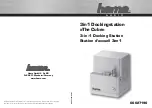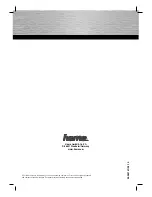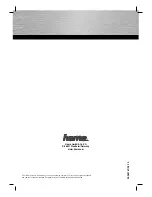
La Crosse Technology, Ltd.
Page 10
Press and hold the SET button for 2 seconds and the selected value will flash. Press and release the
▲UP ARROW button or ▼DOWN ARROW button to set the alarm value.
Note:
Hold the arrow button in to change the value faster.
Press the ALARM button to confirm the setting. The digit will stop flashing.
Activate/Deactivate Alarm
Press the SET button to switch the Alarm On or Off. The alarm icon
indicates the alarm is
switched ON.
Press the SET button again. The alarm icon should disappear and that alarm is OFF.
Press the ALARM button once.
Note:
when there is RF (radio frequency) interference, the interference may cause false high
readings that can set off the alarm,
Winter storage for rain sensor
All our rain sensors can handle the cold temperatures. We leave them out all year long.
However, if you prefer to store the rain sensor for the winter, remember:
Remove batteries when storing to prevent leakage.
In the spring take the rain sensor out of storage and try the
quick connect
.
When the rain sensor is outside all winter and is snow covered, you may see a rain count when the
snow begins to melt and run into the rain sensor. This will not be an accurate measurement for snow.
Mounting/Positioning outdoor sensor
First, set everything up in the house to be sure it works before mounting the sensors outside
.
For best RF (radio frequency) signal, mount all sensors at least 6 feet in the air.
The thermo-hygro sensor sends directly to the weather station.
When considering the distance from the weather station (200 feet open air) cut that distance in half
for each wall, window, tree, bush or other obstruction in the signal path.
Material such as stucco or metal will absorb a wireless signal.
Windows can reflect the signal.
Ideally the sensor should be at least 6 feet off the ground (higher is fine) for best signal transmission.
Place the thermo-hygro sensor in a well-shaded area protected from direct sun. The sensor will read
high if exposed to the sun.
A good location is under the eaves on the north side of the house.
A small roof or well-vented box is useful if you do not have an overhang.
The thermo-hygro sensor can withstand rain, snow and temperature extremes.
Standing rain and snow may soak into the sensor and cause failure.
If the sensor gets too wet, it will not read accurate humidity.
Protect the thermo-hygro sensor from a downpour.
Light incidental exposure to water typically will not harm the sensor.
Mounting/Positioning wind sensor
For most accurate wind readings, mount the wind sensor as the highest item in the area with a 50
foot clearance in all directions (avoid tall trees, buildings or other obstructions that may block or
reflect the wind).
The wind sensor transmits directly to the thermohygro sensor. When considering the distance from
the thermohygro sensor (200 feet open air) cut that distance in half for each tree, bush or other
obstruction in the signal path.
The wind sensor should be in line-of-sight or the thermohygro sensor. If the wind sensor is on the roof
it may be best to mount the thermohygro sensor on a different building, fence, etc., in line of sight and
less than 200 feet from the wind sensor.
Cups should be below the wind mast.
Material such as stucco or metal will absorb a wireless signal.
Observe the proper direction when mounting. The solar panel should receive enough sun to charge if
in any open area. Facing the solar panel south as indicated on the wind sensor provides correct
directional information.


































